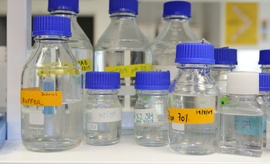Acquired Resistance to Endocrine Treatments Is Associated with Tumor-Specific Molecular Changes in Patient-Derived Luminal Breast Cancer Xenografts
Abstract
Purpose: Patients with luminal breast cancer (LBC) often become endocrine resistant over time. We investigated the molecular changes associated with acquired hormonoresistances in patient-derived xenografts of LBC.
Experimental Design: Two LBC xenografts (HBCx22 and HBCx34) were treated with different endocrine treatments (ET) to obtain xenografts with acquired resistances to tamoxifen (TamR) and ovariectomy (OvaR). PI3K pathway activation was analyzed by Western blot analysis and IHC and responses to ET combined to everolimus were investigated in vivo. Gene expression analyses were performed by RT-PCR and Affymetrix arrays.
Results: HBCx22 TamR xenograft was cross-resistant to several hormonotherapies, whereas HBCx22 OvaR and HBCx34 TamR exhibited a treatment-specific resistance profile. PI3K pathway was similarly activated in parental and resistant xenografts but the addition of everolimus did not restore the response to tamoxifen in TamR xenografts. In contrast, the combination of fulvestrant and everolimus induced tumor regression in vivo in HBCx34 TamR, where we found a cross-talk between the estrogen receptor (ER) and PI3K pathways. Expression of several ER-controlled genes and ER coregulators was significantly changed in both TamR and OvaR tumors, indicating impaired ER transcriptional activity. Expression changes associated with hormonoresistance were both tumor and treatment specific and were enriched for genes involved in cell growth, cell death, and cell survival.
Conclusions: PDX models of LBC with acquired resistance to endocrine therapies show a great diversity of resistance phenotype, associated with specific deregulations of ER-mediated gene transcription. These models offer a tool for developing anticancer therapies and to investigate the dynamics of resistance emerging during pharmacologic interventions. Clin Cancer Res; 20(16); 4314–25. ©2014 AACR.









